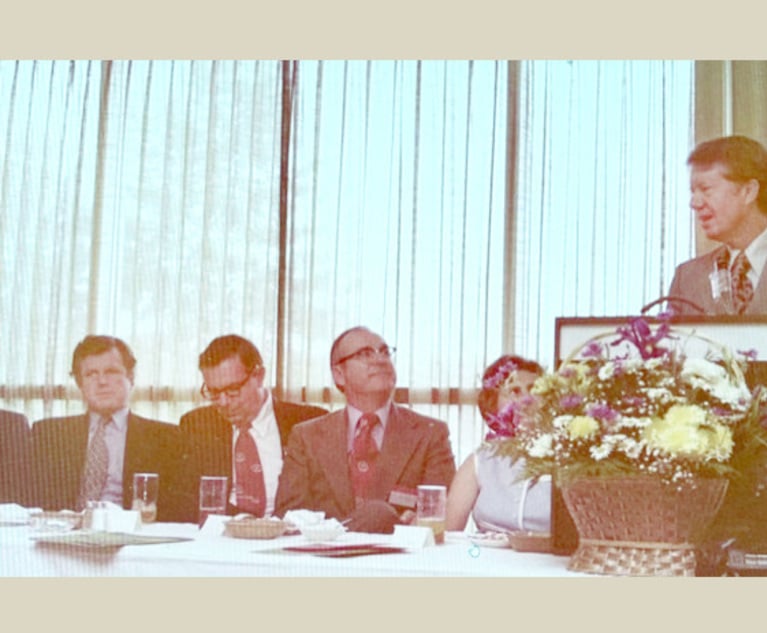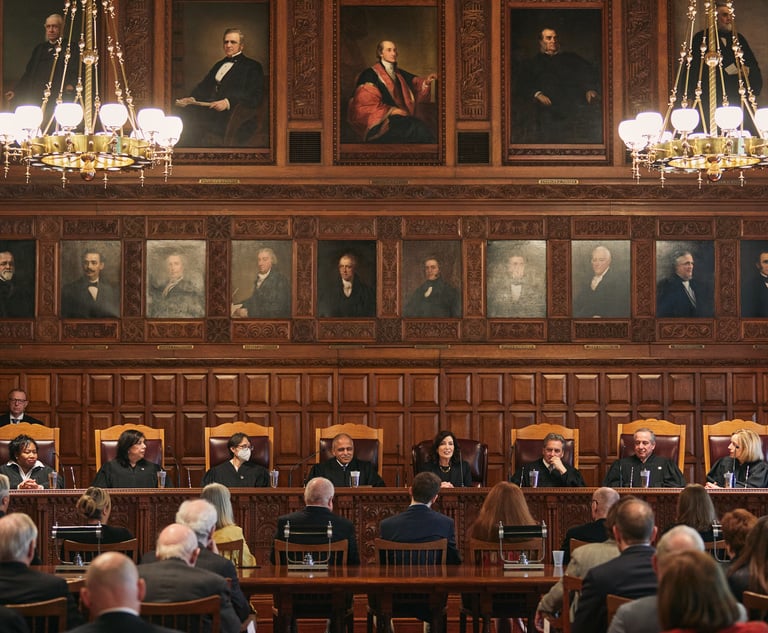 Justice Rolando Acosta, Photo: Rick Kopstein
Justice Rolando Acosta, Photo: Rick KopsteinThe State of the Appellate Division, First Department
I know that some members of the profession are not as excited as I am about making strides in technology and opening the courtroom doors ever wider; but I am a strong believer in the benefits that technology—responsibly used—can bring, both in terms of handling appeals more efficiently and expanding access to justice.
February 28, 2019 at 06:09 PM
7 minute read
I was inspired by Chief Judge Janet DiFiore's recent State of Our Judiciary address, in which she described the tremendous progress that the Unified Court System has made under her excellence initiative. As the chief judge pointed out in relation to trial-level cases, we have focused—with laser precision—on performance measures, particularly reducing the percentage of pending cases that are over “standards and goals” (our benchmark for the timely resolution of cases and an important management tool in measuring our performance when it comes to providing justice to all). What happens at the appellate level, after the excellent and increasingly timely work of trial judges, is also an important part of the narrative.
When I became presiding justice of the Appellate Division, First Judicial Department in May 2017, I set forth several priorities, which included increasing our efficiency to reduce the number of pending appeals and modernizing the court with initiatives like e-filing and live-streaming oral arguments. These undertakings are intended to promote transparency, demystify our processes, increase access to justice and engender public confidence in the judiciary.
I am pleased to report that the First Department, which has long been one of the most efficient and productive courts in the state, continues to shine. For the second consecutive calendar year, we closed with the lowest number of pending appeals in recent memory and disposed of more appeals than were perfected.[1] During the 2017 calendar year, our court disposed of 3,262 appeals (including 219 appeals that were settled through the pre-argument conference program, i.e., mediation), 52 more than were perfected that year. Similarly, during the 2018 calendar year, we disposed of 3,155 appeals (including 254 that were settled through mediation), 51 more than were perfected. As of December 31, 2018, the court had only 36 pending cases, a number we expect to significantly reduce by the end of June.
In addition, the First Department decided 5,580 motions in 2017 and 5,638 motions in 2018, many of which sought stays of trial or other types of immediate relief and thus required expedited treatment. We also evaluated and admitted 2,568 attorneys in 2017 and 2,661 in 2018, and reduced the average admissions timeframe (the amount of time it takes attorneys to be admitted after our Committee on Character and Fitness receives their completed applications) from approximately six months to less than 60 days by increasing the number of interview dates and admission sessions.
I attribute our court's productivity not only to the tenacious efforts of our excellent judges and staff but also to its unique calendaring system (insofar as appeals are concerned). That system is largely driven by the litigants, who can perfect an appeal for a given term within the timeframe outlined in the rules and rest assured that they will typically be able to argue the case in the same term, and can expect a published decision in an average of four to five weeks.
Certainly, an integral component of increasing our efficiency is technology. That is why, as I wrote in the New York State Bar Association Journal last spring, we are bringing the First Department into the 21st Century. Our noble profession tends to revere the past, perhaps rightfully so in some instances—such as when we cite a century-old Cardozo decision. So, I know that some members of the profession are not as excited as I am about making strides in technology and opening the courtroom doors ever wider; but I am a strong believer in the benefits that technology—responsibly used—can bring, both in terms of handling appeals more efficiently and expanding access to justice.
Indeed, since I took the helm at the First Department, we have modernized the court in a variety of ways, including replacing our antiquated computer servers, which had nearly slowed the work of our staff to a halt. We began live-streaming oral arguments and making the recordings available on our website, thus increasing transparency. We enacted a personal electronic device policy, which permits lawyers and litigants to use laptops, tablets and the like during their oral arguments. And we obtained the court system's first Surface Hub, a 55” touchscreen computer, now supplemented by two 86” Dell touchscreen computers, which—once fully implemented—will facilitate the presentation of record evidence in the courtroom, CLEs and teleconferencing.
In March 2018, the court commenced e-filing of commercial appeals, and, of the four departments of the Appellate Division, the First Department has received the largest number of e-filed cases. Through December 31, 2018, 1,085 commercial appeals and a total of 7,090 documents have been e-filed at the First Department. We are also beginning to track notices of appeal, something that was never done in the past, to give us a better understanding of the types of cases that are appealed to our court.
And our most ambitious projects are still to come. We are currently developing a state-of-the-art case-management system that promises to increase our efficiency and provide us with the detailed reporting that is required to effectively manage an operation like ours. For example, whereas our current, antiquated system tracks limited categories of cases, such as the number of civil versus criminal cases, the new system will be able to further categorize the entire inventory of appeals by case type, including how many commercial cases are filed and whether they are from interlocutory or final orders. In addition, we are preparing to expand e-filing to other case types, launch a new and improved website, and update the font and formatting of our judicial writings.
Of course, while I am proud of the steps toward modernization we have taken, I fully recognize that one of our missions must be to maintain our reputation for serving attorneys and litigants from the moment they enter our courthouse. I am gratified by the dedication and professionalism of our court's employees. While most work behind the scenes, out of the public eye, those in the clerk's office are the frontline in processing the tremendous numbers of appeals and motions that are filed in our court, and in helping attorneys and pro se litigants understand our procedures. They continue to be at the forefront of innovation as we implement e-filing, the new statewide rules of appellate practice, and other efforts to modernize the court.
As you can see, we are building the “appellate court of the future,” one that will be more nimble, responsive and efficient than ever before. But we can't do this alone. I am sure there are many ways in which technological advances and other initiatives will improve the appellate experience for the attorneys and litigants who appear before us. With the collaboration of the bar and the stakeholders in our exceptional system of justice, I am confident that we will continue our tradition of excellence as one of the most respected intermediate appellate courts in the country.
[1] Although it may seem mathematically impossible at first glance, the number of appeals disposed of can be higher than the number of appeals perfected because there are several types of dispositions, including withdrawals of cases that were not perfected (many of which were settled through our mediation program) and transfers to other departments, and because our court may dispose of cases from prior years.
Rolando Acosta is the presiding justice of the Appellate Division, First Department.
This content has been archived. It is available through our partners, LexisNexis® and Bloomberg Law.
To view this content, please continue to their sites.
Not a Lexis Subscriber?
Subscribe Now
Not a Bloomberg Law Subscriber?
Subscribe Now
NOT FOR REPRINT
© 2025 ALM Global, LLC, All Rights Reserved. Request academic re-use from www.copyright.com. All other uses, submit a request to [email protected]. For more information visit Asset & Logo Licensing.
You Might Like
View All
Jimmy Carter’s 1974 Law Day Speech: A Call for Lawyers to Do the Public Good
14 minute readTrending Stories
- 1The Importance of Contractual Language in Analyzing Post-Closing Earnout Disputes
- 2People in the News—Jan. 8, 2025—Stevens & Lee, Ogletree Deakins
- 3How I Made Partner: 'Avoid Getting Stuck in a Moment,' Says Federico Cuadra Del Carmen of Baker McKenzie
- 4Legal Departments Dinged for Acquiescing to Rate Hikes That 'Defy Gravity'
- 5Spalding Jurors Return $12M Verdict Against State Farm Insurance Client
Who Got The Work
Michael G. Bongiorno, Andrew Scott Dulberg and Elizabeth E. Driscoll from Wilmer Cutler Pickering Hale and Dorr have stepped in to represent Symbotic Inc., an A.I.-enabled technology platform that focuses on increasing supply chain efficiency, and other defendants in a pending shareholder derivative lawsuit. The case, filed Oct. 2 in Massachusetts District Court by the Brown Law Firm on behalf of Stephen Austen, accuses certain officers and directors of misleading investors in regard to Symbotic's potential for margin growth by failing to disclose that the company was not equipped to timely deploy its systems or manage expenses through project delays. The case, assigned to U.S. District Judge Nathaniel M. Gorton, is 1:24-cv-12522, Austen v. Cohen et al.
Who Got The Work
Edmund Polubinski and Marie Killmond of Davis Polk & Wardwell have entered appearances for data platform software development company MongoDB and other defendants in a pending shareholder derivative lawsuit. The action, filed Oct. 7 in New York Southern District Court by the Brown Law Firm, accuses the company's directors and/or officers of falsely expressing confidence in the company’s restructuring of its sales incentive plan and downplaying the severity of decreases in its upfront commitments. The case is 1:24-cv-07594, Roy v. Ittycheria et al.
Who Got The Work
Amy O. Bruchs and Kurt F. Ellison of Michael Best & Friedrich have entered appearances for Epic Systems Corp. in a pending employment discrimination lawsuit. The suit was filed Sept. 7 in Wisconsin Western District Court by Levine Eisberner LLC and Siri & Glimstad on behalf of a project manager who claims that he was wrongfully terminated after applying for a religious exemption to the defendant's COVID-19 vaccine mandate. The case, assigned to U.S. Magistrate Judge Anita Marie Boor, is 3:24-cv-00630, Secker, Nathan v. Epic Systems Corporation.
Who Got The Work
David X. Sullivan, Thomas J. Finn and Gregory A. Hall from McCarter & English have entered appearances for Sunrun Installation Services in a pending civil rights lawsuit. The complaint was filed Sept. 4 in Connecticut District Court by attorney Robert M. Berke on behalf of former employee George Edward Steins, who was arrested and charged with employing an unregistered home improvement salesperson. The complaint alleges that had Sunrun informed the Connecticut Department of Consumer Protection that the plaintiff's employment had ended in 2017 and that he no longer held Sunrun's home improvement contractor license, he would not have been hit with charges, which were dismissed in May 2024. The case, assigned to U.S. District Judge Jeffrey A. Meyer, is 3:24-cv-01423, Steins v. Sunrun, Inc. et al.
Who Got The Work
Greenberg Traurig shareholder Joshua L. Raskin has entered an appearance for boohoo.com UK Ltd. in a pending patent infringement lawsuit. The suit, filed Sept. 3 in Texas Eastern District Court by Rozier Hardt McDonough on behalf of Alto Dynamics, asserts five patents related to an online shopping platform. The case, assigned to U.S. District Judge Rodney Gilstrap, is 2:24-cv-00719, Alto Dynamics, LLC v. boohoo.com UK Limited.
Featured Firms
Law Offices of Gary Martin Hays & Associates, P.C.
(470) 294-1674
Law Offices of Mark E. Salomone
(857) 444-6468
Smith & Hassler
(713) 739-1250









